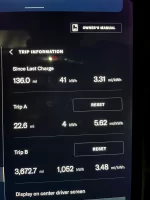Let me ask some awkward questions (not just to Bobby, anyone can chime-in):
> Yes, Lucid was simply quoting EPG numbers, hence they are not lying.
Correct, except it's the EPA.
>There is no implied guarantee that you will get the EPA range unless you replicate the exact EPA test condition. Right?
Correct, because that is how physics works, yes. It is also not guaranteed that the temperature tomorrow will be the same as today or that there will be more or fewer cars on the road or that there will or won't be a power outage. Hell, one of us may not even wake up tomorrow.
The whole point of the EPA testing is to test vehicles under the
same set of conditions, providing us with a
relative comparison for their efficiencies. It is not and was never intended to be a 'promise' or 'guarantee' of what you'd get under all conditions. That would be an absurd question, given how many factors there are.
It is unfortunate that the EPA offers two methods of testing, a 2-cycle and 5-cycle test, thus muddying their goals of it being a valid relative comparison, but nevertheless, that is not Lucid's fault.
> Isn't EPA testing done on a dynamometer? If YES, was there any wind-resistance effect in EPA rating? Or is it "derated" using a "fudge-factor" to account for the "unknowns"?
Yes. I have no idea. Yes, it is 'derated' using a 'fudge factor'.
> It is well debated in this forum that speed and wind resistance is a BIG part of the efficiency, hence the achievable mi/kWh, correct?
No, it is not well-debated. It is well-understood as fact.
> If so, how is a scalar "Fudge-Factor" going to account for a quadratic wind resistance effect? In other words, is EPA rating meaningful in any real-life highway driving condition when it comes to efficiency?
Yes, because it is meant to be a comparison
relative to other EVs, in addition to a meaningful estimate for travel. Moreover,
plenty of people achieve EPA range, just not in cold weather and driving 85mph+. Drive like the EPA, and you get EPA range.
> Now, WHO decides on the "Fuge-Factor"? Is it the EPA? Or is it "in conjunction" with the auto manufacturer? Or do the auto manufacturers simply tell EPG what number to plug in?
The EPA applies a 0.7 adjustment factor, effectively reducing the laboratory-tested range by 30%. While 0.7 is the most common, manufacturers can use a different adjustment factor if they believe their vehicle will perform better or worse in real-world driving conditions than the 0.7 factor would suggest. Tesla is an example of a manufacturer that uses a different factor.
Lucid does not.
The adjusted city and highway range values are then weighted (55% city, 45% highway) to calculate the combined range displayed on the EPA fuel economy label.
> If the "Fudge Factor" is determined in conjunction with the auto manufacturer, why are Tesla and Lucid significantly worse when independent tester compare than EPA achievable mi/kWh whilst the Germany manufacturers often met or exceed their mi/kWh rating?
Because, for the sixteen thousandth time,
they use the 5-cycle test, and other manufacturers
use the 2-cycle test.
That's it. There's no conspiracy. That's the end of it. That's the reason. Believe it or don't, but it is the truth. That is the reason. Please stop asking the same question and seeking a different answer. It is very,
very annoying. There is no other answer. This is the answer. This is the correct and only answer. Lucid and Tesla use the more expensive, but better looking, 5-cycle test. The german manufacturers use the 2-cycle test. That is the reason.
In case you missed it, Lucid and Tesla use the more expensive, but better looking, 5-cycle test, so their numbers look better than the German manufacturers, because the German manufacturers don't spend the money on the additional testing. It isn't because the German manufacturers are somehow better people to their customers and are altruistic.
The reason is Lucid and Tesla use the more expensive, but better looking, 5-cycle test. The german manufacturers use the 2-cycle test. That is the reason.
In addition,
Tesla adjusts the fudge factor to make theirs look even better. Lucid does not.
Feel free to correct any mist-statements on my part.

(To be clear, the sarcasm in this post is not directed at OP or anyone else in this thread.
@BS8899 has been after this EPA range conspiracy for as long as I can remember, which is likely why I have tired of it, and I
know I'm not alone. I apologize for my tone, but I'm tired)

